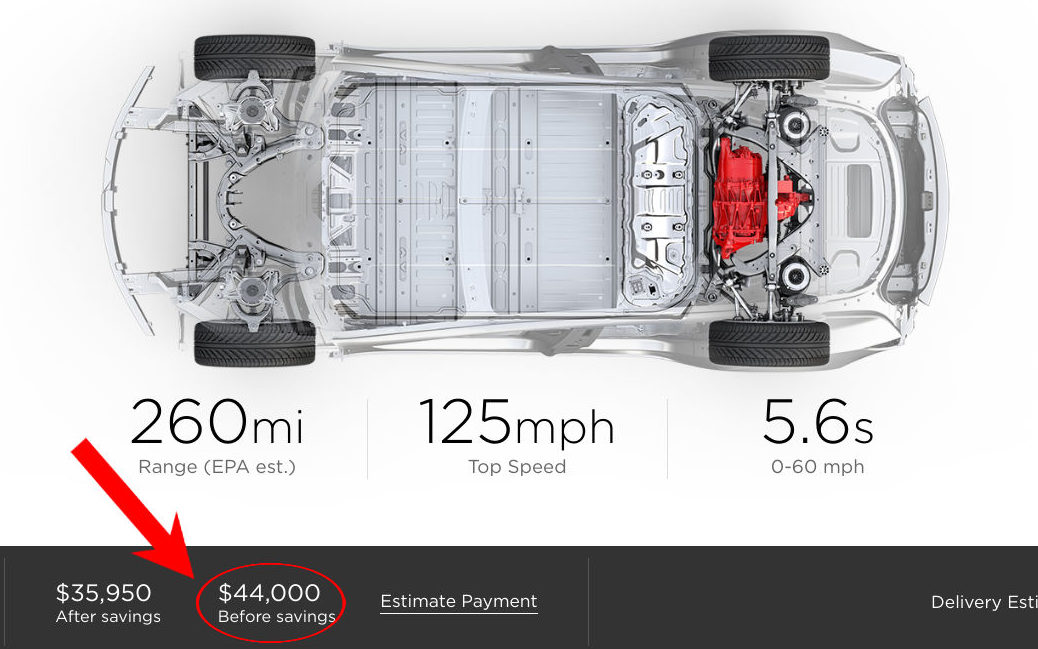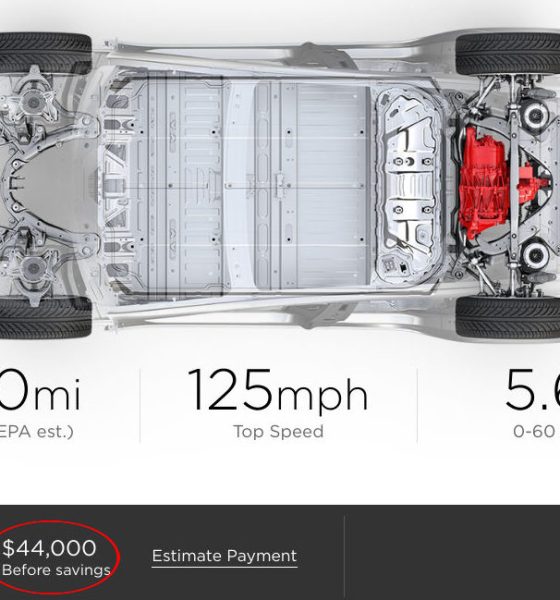

News
Tesla adjusts Model 3 prices amid lowered $3,750 federal tax credit
To say that the past year has been monumental for Tesla is a gross understatement. By the end of 2018, the electric car maker had established itself as a leader in the premium EV market, and the Model 3, its most ambitious vehicle, continues to perform well. Seemingly as a means to ensure that the electric sedan remains competitive regardless of the phaseout of the $3,750 federal tax credit, Tesla has adjusted the prices of its Model 3 lineup.
With the recent price adjustments in place, the Mid Range Model 3 RWD — the most affordable version of the vehicle currently available — is now priced at $44,000 before incentives. This is $1,000 less than the vehicle’s introductory price of $45,000 and $2,000 less than the electric sedan’s $46,000 cost, which was in effect until the end of 2018. The most recent price adjustments also lowered the price of the Tesla Model 3 Performance to $62,000 before incentives. The Dual Motor AWD variant, on the other hand, is now priced at $51,000 before gas savings and the remaining $3,750 tax credit.
https://twitter.com/28delayslater/status/1080429285112979456
By adopting this pricing strategy, Tesla is all but ensuring that its customers would not feel the full brunt of the $7,500 federal tax credit’s phaseout. Had Tesla not rolled back its vehicles’ prices, the cost of the entire Model 3 line would increase by $3,750 after 2018 ended. With the current adjustments in place, though, $2,000 of the lost tax credit would practically be covered by Tesla. Thus, for all intents and purposes, it appears that the phaseout of the $7,500 federal tax credit only resulted in Tesla’s vehicles raising their total prices by about $1,750.
Such adjustments could be yet another strategy for Tesla to ensure that demand in the United States remains healthy despite the vehicle’s international rollout. A notable portion of the electric car’s remaining reservation holders in the US, after all, are likely waiting for the Model 3’s $35,000 base variant. So far, Tesla’s website notes that Model 3 equipped with a Standard Battery would be available in 4 to 6 months.
Tesla is yet to release its production and delivery figures for the fourth quarter of 2018, though estimates from the electric car community expect the automaker to deliver around 33,000 vehicles in December, of which about 24,500 were Model 3. Considering that Tesla reportedly hit a production rate of 1,000 Model 3 per day in Q4, and considering that the company was pushing deliveries until the end of the year, there is a good chance that the electric car maker has achieved yet another record-setting quarter.
The next 12 months would likely go down as Tesla’s most historic year yet. Apart from the international rollout of the Model 3, the company is also expected to unveil the Model Y SUV this year. Just like the Model 3, the Model Y is aimed at the mass market, and considering the industry’s preference for SUVs, expectations are high that demand for the Model Y would exceed even that of the electric sedan. This is not all, though, as Elon Musk has teased that the Tesla Truck might be unveiled in 2019, and initial production of its all-electric long hauler — the Semi — could enter its first phases sometime this year as well. Lastly, Tesla’s Energy products such as the Solar Roof, which also has a long line of reservation holders, is expected to ramp production in 2019.

Elon Musk
Elon Musk’s X will start using a Tesla-like software update strategy
The initiative seems designed to accelerate updates to the social media platform, while maintaining maximum transparency.

Elon Musk’s social media platform X will adopt a Tesla-esque approach to software updates for its algorithm.
The initiative seems designed to accelerate updates to the social media platform, while maintaining maximum transparency.
X’s updates to its updates
As per Musk in a post on X, the social media company will be making a new algorithm to determine what organic and advertising posts are recommended to users. These updates would then be repeated every four weeks.
“We will make the new 𝕏 algorithm, including all code used to determine what organic and advertising posts are recommended to users, open source in 7 days. This will be repeated every 4 weeks, with comprehensive developer notes, to help you understand what changed,” Musk wrote in his post.
The initiative somewhat mirrors Tesla’s over-the-air update model, where vehicle software is regularly refined and pushed to users with detailed release notes. This should allow users to better understand the details of X’s every update and foster a healthy feedback loop for the social media platform.
xAI and X
X, formerly Twitter, has been acquired by Elon Musk’s artificial intelligence startup, xAI last year. Since then, xAI has seen a rapid rise in valuation. Following the company’s the company’s upsized $20 billion Series E funding round, estimates now suggest that xAI is worth tens about $230 to $235 billion. That’s several times larger than Tesla when Elon Musk received his controversial 2018 CEO Performance Award.
As per xAI, the Series E funding round attracted a diverse group of investors, including Valor Equity Partners, Stepstone Group, Fidelity Management & Research Company, Qatar Investment Authority, MGX, and Baron Capital Group, among others. Strategic partners NVIDIA and Cisco Investments also continued support for building the world’s largest GPU clusters.
News
Tesla FSD Supervised wins MotorTrend’s Best Driver Assistance Award
The decision marks a notable reversal for the publication from prior years, with judges citing major real-world improvements that pushed Tesla’s latest FSD software ahead of every competing ADAS system.

Tesla’s Full Self-Driving (Supervised) system has been named the best driver-assistance technology on the market, earning top honors at the 2026 MotorTrend Best Tech Awards.
The decision marks a notable reversal for the publication from prior years, with judges citing major real-world improvements that pushed Tesla’s latest FSD software ahead of every competing ADAS system. And it wasn’t even close.
MotorTrend reverses course
MotorTrend awarded Tesla FSD (Supervised) its 2026 Best Tech Driver Assistance title after extensive testing of the latest v14 software. The publication acknowledged that it had previously criticized earlier versions of FSD for erratic behavior and near-miss incidents, ultimately favoring rivals such as GM’s Super Cruise in earlier evaluations.
According to MotorTrend, the newest iteration of FSD resolved many of those shortcomings. Testers said v14 showed far smoother behavior in complex urban scenarios, including unprotected left turns, traffic circles, emergency vehicles, and dense city streets. While the system still requires constant driver supervision, judges concluded that no other advanced driver-assistance system currently matches its breadth of capability.
Unlike rival systems that rely on combinations of cameras, radar, lidar, and mapped highways, Tesla’s FSD operates using a camera-only approach and is capable of driving on city streets, rural roads, and freeways. MotorTrend stated that pure utility, the ability to handle nearly all road types, ultimately separated FSD from competitors like Ford BlueCruise, GM Super Cruise, and BMW’s Highway Assistant.
High cost and high capability
MotorTrend also addressed FSD’s pricing, which remains significantly higher than rival systems. Tesla currently charges $8,000 for a one-time purchase or $99 per month for a subscription, compared with far lower upfront and subscription costs from other automakers. The publication noted that the premium is justified given FSD’s unmatched scope and continuous software evolution.
Safety remained a central focus of the evaluation. While testers reported collision-free operation over thousands of miles, they noted ongoing concerns around FSD’s configurable driving modes, including options that allow aggressive driving and speeds beyond posted limits. MotorTrend emphasized that, like all Level 2 systems, FSD still depends on a fully attentive human driver at all times.
Despite those caveats, the publication concluded that Tesla’s rapid software progress fundamentally reshaped the competitive landscape. For drivers seeking the most capable hands-on driver-assistance system available today, MotorTrend concluded Tesla FSD (Supervised) now stands alone at the top.
News
Elon Musk’s Grokipedia surges to 5.6M articles, almost 79% of English Wikipedia
The explosive growth marks a major milestone for the AI-powered online encyclopedia, which was launched by Elon Musk’s xAI just months ago.

Elon Musk’s Grokipedia has grown to an impressive 5,615,201 articles as of today, closing in on 79% of the English Wikipedia’s current total of 7,119,376 articles.
The explosive growth marks a major milestone for the AI-powered online encyclopedia, which was launched by Elon Musk’s xAI just months ago. Needless to say, it would only be a matter of time before Grokipedia exceeds English Wikipedia in sheer volume.
Grokipedia’s rapid growth
xAI’s vision for Grokipedia emphasizes neutrality, while Grok’s reasoning capabilities allow for fast drafting and fact-checking. When Elon Musk announced the initiative in late September 2025, he noted that Grokipedia would be an improvement to Wikipedia because it would be designed to avoid bias.
At the time, Musk noted that Grokipedia “is a necessary step towards the xAI goal of understanding the Universe.”
Grokipedia was launched in late October, and while xAI was careful to list it only as Version 0.1 at the time, the online encyclopedia immediately earned praise. Wikipedia co-founder Larry Sanger highlighted the project’s innovative approach, noting how it leverages AI to fill knowledge gaps and enable rapid updates. Netizens also observed how Grokipedia tends to present articles in a more objective manner compared to Wikipedia, which is edited by humans.
Elon Musk’s ambitious plans
With 5,615,201 total articles, Grokipedia has now grown to almost 79% of English Wikipedia’s article base. This is incredibly quick, though Grokipedia remains text-only for now. xAI, for its part, has now updated the online encyclopedia’s iteration to v0.2.
Elon Musk has shared bold ideas for Grokipedia, including sending a record of the entire knowledge base to space as part of xAI’s mission to preserve and expand human understanding. At some point, Musk stated that Grokipedia will be renamed to Encyclopedia Galactica, and it will be sent to the cosmos.
“When Grokipedia is good enough (long way to go), we will change the name to Encyclopedia Galactica. It will be an open source distillation of all knowledge, including audio, images and video. Join xAI to help build the sci-fi version of the Library of Alexandria!” Musk wrote, adding in a later post that “Copies will be etched in stone and sent to the Moon, Mars and beyond. This time, it will not be lost.”








